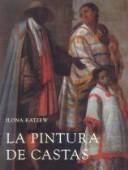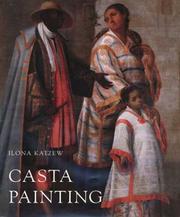| Listing 1 - 10 of 11 | << page >> |
Sort by
|

ISBN: 8475066380 Year: 2004 Publisher: Madrid Turner
Abstract | Keywords | Export | Availability | Bookmark
 Loading...
Loading...Choose an application
- Reference Manager
- EndNote
- RefWorks (Direct export to RefWorks)
Painting --- anno 1700-1799 --- Mexico

ISBN: 9780300102413 Year: 2005 Publisher: New Haven Yale university press
Abstract | Keywords | Export | Availability | Bookmark
 Loading...
Loading...Choose an application
- Reference Manager
- EndNote
- RefWorks (Direct export to RefWorks)
Book
ISBN: 0804772584 9780804772587 9780804761406 9780804761413 0804761418 080476140X Year: 2009 Publisher: Stanford, Calif. Stanford University Press
Abstract | Keywords | Export | Availability | Bookmark
 Loading...
Loading...Choose an application
- Reference Manager
- EndNote
- RefWorks (Direct export to RefWorks)
This innovative and provocative volume focuses on the historical development of racial thinking and imagining in Mexico and the southwestern United States over a period of almost five centuries, from the earliest decades of Spanish colonial rule and the birth of a multiracial colonial population, to the present. The distinguished contributors to the volume bring into dialogue sophisticated new scholarship from an impressive range of disciplines, including social and cultural history, art history, legal studies, and performance art. The essays provide an engaging and original framework for
Ethnicity --- Race in art --- Race in literature --- Racism --- Bias, Racial --- Race bias --- Race prejudice --- Racial bias --- Prejudices --- Anti-racism --- Critical race theory --- Race relations --- Ethnic identity --- Group identity --- Cultural fusion --- Multiculturalism --- Cultural pluralism --- History --- Mexico --- Southwestern States --- Southwestern United States --- United States, Southwestern --- Anáhuac --- Estados Unidos Mexicanos --- Maxico --- Méjico --- Mekishiko --- Meḳsiḳe --- Meksiko --- Meksyk --- Messico --- Mexique (Country) --- República Mexicana --- Stany Zjednoczone Meksyku --- United Mexican States --- United States of Mexico --- מקסיקו --- メキシコ
Book
ISBN: 9780300176643 0300176643 Year: 2011 Publisher: Los Angeles, Calif. Los Angeles County Museum of Art
Abstract | Keywords | Export | Availability | Bookmark
 Loading...
Loading...Choose an application
- Reference Manager
- EndNote
- RefWorks (Direct export to RefWorks)
Contested Visions offers a comparative view of the two principal viceroyalties of Spanish America: Mexico and Peru. Spanning developments from the 15th to the 19th century, this ambitious book looks at the many ways and contexts in which indigenous peoples were represented in art of the early modern periodby colonial artists, European artists, and themselves. More than two hundred works of art, including paintings, sculptures, illustrated books, maps, codices, manuscripts, and other materials such as textiles, keros, and feather works, are reproduced in full-color illustrations, demonstrating the rich variety of these artistic approaches. A collection of essays by an international team of distinguished scholars in the field uncovers the different meanings and purposes behind these depictions of native populations of the Americas. These experts explore the role of the visual arts in negotiating a sense of place in late pre-Columbian and colonial Latin America. They address a range of important topics, such as the construct of the Indian as a good Christian; how Amerindians drew on their pre-Columbian past to stake out a place within the Spanish body politic; their participation in festive rites; and their role as artists. Lavishly illustrated, this ambitious book provides a compelling and original framework by which to understand the intersection of vision and power in the Spanish colonial world.
Peruvian --- Spanish [culture or style] --- iconography --- indigenous people --- Colonial Latin American fine arts styles --- Iconography --- Art --- Mexican --- Museo Nacional de Historia [Mexico City] --- anno 1400-1499 --- anno 1500-1599 --- anno 1700-1799 --- anno 1800-1899 --- anno 1600-1699 --- Peru --- Mexico --- Art, Spanish colonial --- Indian art --- Art colonial espagnol --- Art indien d'Amérique --- Exhibitions --- Expositions --- Art indien d'Amérique --- Art and society --- Art, Indian --- Indian art, Modern --- Indians --- Pre-Columbian art --- Precolumbian art --- Spanish colonial art --- Art, Colonial --- Art and sociology --- Society and art --- Sociology and art --- Themes, motives --- Social aspects --- Art, Spanish colonial - Latin America - Themes, motives - Exhibitions. --- Indian art - Latin America - Themes, motives - Exhibitions. --- Art and society - Latin America - Exhibitions.
Book

ISBN: 9780300191011 0300191014 Year: 2014 Publisher: New Haven, Conn. Yale University Press
Abstract | Keywords | Export | Availability | Bookmark
 Loading...
Loading...Choose an application
- Reference Manager
- EndNote
- RefWorks (Direct export to RefWorks)
" Painting in Latin America, 1550-1820: From Conquest to Independence surveys the diverse styles, subjects, and iconography of painting in Latin America between the 16th and 19th centuries. While European art forms were widely disseminated, copied, and adapted throughout Latin America, colonial painting is not a derivative extension of Europe. The ongoing debate over what to call it-mestizo, hybrid, creole, indo-hispanic, tequitqui-testifies to a fundamental yet unresolved question of identity. Comparing and contrasting the Viceroyalties of New Spain, with its center in modern-day Mexico, and Peru, the authors explore the very different ways the two regions responded to the influence of the Europeans and their art. A wide range of art and artists are considered, some for the first time. Rich with new photography and primary research, this book delivers a wealth of new insight into the history of images and the history of art"--
Painting, Colonial --- Painting, Latin American --- Peinture coloniale --- Peinture latino-américaine --- Peinture latino-américaine --- Painting --- anno 1500-1799 --- anno 1800-1899 --- Latin America
Book

ISBN: 9788494006166 Year: 2014 Publisher: Madrid Ediciones El Viso / Fomento Cultural Banamex
Abstract | Keywords | Export | Availability | Bookmark
 Loading...
Loading...Choose an application
- Reference Manager
- EndNote
- RefWorks (Direct export to RefWorks)
Painting --- painting [image-making] --- Colonial Latin American fine arts styles --- Peruvian --- invloed van de noordelijke scholen --- anno 1500-1599 --- anno 1600-1699 --- anno 1700-1799 --- Latin America
Book

ISBN: 9783791356778 Year: 2017 Publisher: Munich DelMonico Books-Prestel
Abstract | Keywords | Export | Availability | Bookmark
 Loading...
Loading...Choose an application
- Reference Manager
- EndNote
- RefWorks (Direct export to RefWorks)
Painting --- painting [image-making] --- Mexican --- anno 1700-1799 --- Mexico
Book

ISBN: 9786074843170 6074843171 Year: 2012 Publisher: México, D.F. Instituto Nacional de Antropología e Historia
Abstract | Keywords | Export | Availability | Bookmark
 Loading...
Loading...Choose an application
- Reference Manager
- EndNote
- RefWorks (Direct export to RefWorks)
History of civilization --- exhibition catalogs --- social anthropology --- Aztec [culture or style] --- Inca [culture, general] --- social anthropologists --- Mexico --- Peru --- Art and society --- Art, Spanish Colonial --- Indian art --- Exhibitions --- Themes, motives --- Exhibitions. --- Art and society - Latin America - Exhibitions --- Art and society - Exhibitions --- Art, Spanish Colonial - Latin America - Themes, motives - Exhibitions --- Indian art - Latin America - Themes, motives - Exhibitions --- Art, Spanish Colonial - Exhibitions --- Indian art - Exhibitions.
Book

Year: 2022 Publisher: New York, N.Y. DelMonico Books - D.A.P.
Abstract | Keywords | Export | Availability | Bookmark
 Loading...
Loading...Choose an application
- Reference Manager
- EndNote
- RefWorks (Direct export to RefWorks)
Art --- art collections --- Colonial Latin American styles --- Los Angeles County Museum of Art [Los Angeles, Calif.] --- anno 1500-1799 --- Spain --- Latin America
Book

ISBN: 9780292753105 0292753101 9780292753099 0292753098 Year: 2021 Publisher: Austin
Abstract | Keywords | Export | Availability | Bookmark
 Loading...
Loading...Choose an application
- Reference Manager
- EndNote
- RefWorks (Direct export to RefWorks)
Over the course of some two centuries following the conquests and consolidations of Spanish rule in the Americas during the late fifteenth and early sixteenth centuries—the period designated as the Baroque—new cultural forms sprang from the cross-fertilization of Spanish, Amerindian, and African traditions. This dynamism of motion, relocation, and mutation changed things not only in Spanish America, but also in Spain, creating a transatlantic Hispanic world with new understandings of personhood, place, foodstuffs, music, animals, ownership, money and objects of value, beauty, human nature, divinity and the sacred, cultural proclivities—a whole lexikon of things in motion, variation, and relation to one another. Featuring the most creative thinking by the foremost scholars across a number of disciplines, the Lexikon of the Hispanic Baroque is a uniquely wide-ranging and sustained exploration of the profound cultural transfers and transformations that define the transatlantic Spanish world in the Baroque era. Pairs of authors—one treating the peninsular Spanish kingdoms, the other those of the Americas—provocatively investigate over forty key concepts, ranging from material objects to metaphysical notions. Illuminating difference as much as complementarity, departure as much as continuity, the book captures a dynamic universe of meanings in the various midst of its own re-creations. The Lexikon of the Hispanic Baroque joins leading work in a number of intersecting fields and will fire new research—it is the indispensible starting point for all serious scholars of the early modern Spanish world.
Civilization, Baroque. --- Civilization, Hispanic. --- America --- Spain --- Civilization. --- Civilization
| Listing 1 - 10 of 11 | << page >> |
Sort by
|

 Search
Search Feedback
Feedback About UniCat
About UniCat  Help
Help News
News